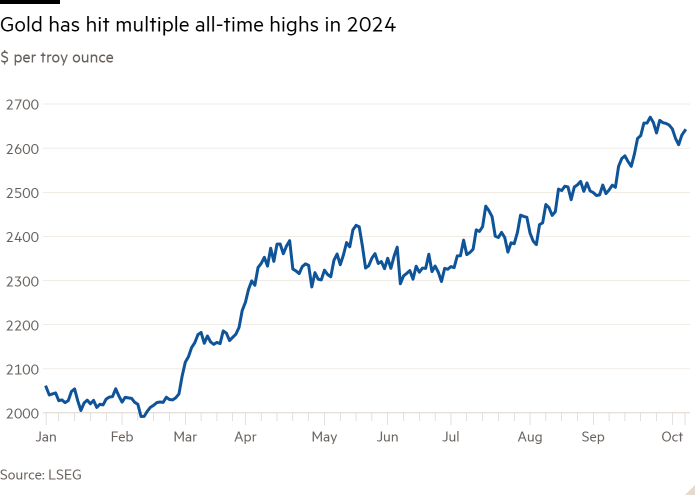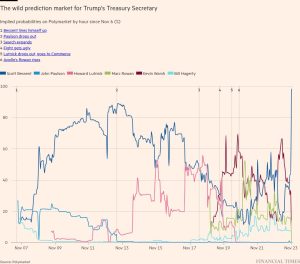Golden times for gold fans

Unlock the Editor’s Digest for free
Roula Khalaf, Editor of the FT, selects her favourite stories in this weekly newsletter.
This year for gold bugs has gone something like this: Heads, I win. Tails, I also win. The yellow metal, as hackneyed journalese demands we call it on second mention, has had quite a run. The price is up by more than a quarter over the course of 2024, hovering now at a little above $2,600 a troy ounce.
This has worked out beautifully for investors, even if often for unintended reasons. Fahad Kamal, chief investment officer at Coutts, told me this week that around a year ago, he loaded up on gold really just as a hedge. He correctly predicted that risky assets would have a good year, and took on extra gold because of its famed tendency to push higher in price when the bad stuff hits the fan and riskier assets decline — a clear danger in this geopolitical environment. This is gold’s common role as a backstop just in case something goes wrong with positive bets on riskier assets such as low-rated corporate bonds or US stocks.
Well, nothing went wrong with those positive bets on risky assets — they have had a great run, in fact — and yet even despite that, gold has put in a sparkling performance. So much so, that Kamal has closed his bet on gold to lock in his gains. “We chose to take profits, and seek diversification elsewhere,” he said.
The urge to take your winnings at this point and run is understandable, not least because the 26 per cent rally in gold this year in some ways masks what an incredible ride this asset has been on. The benchmark price was under $2,000 as recently as February. From that low point to the high struck in late September, the rally clocks in at a cool 35 per cent.
The perennial problem with gold, though, is articulating why this has happened. It is just not like other commodities, which respond more neatly to industrial demand and supply, or to instruments that pay out interest or dividends like stocks and bonds. At least in theory, their price movements are driven by shifts in creditworthiness and future earnings or at the very least, the economy.
Some investors like it as a hedge against inflation, which sort of works, except that gold has cranked higher this year while inflation has fallen, and it did nothing to protect portfolios in 2022, when inflation slammed into bonds and stocks. Other gold fans insist the time to buy is not, in fact, when inflation is rising, but when interest rates are falling — it is less painful to own gold, which pays out no interest, when bond yields are lower. Fine, but despite the drama, 10-year US government bond yields have gone the best part of nowhere this year.

The classic bull case for gold is as a place to hide when geopolitics deteriorate. Again, fine, but it’s odd that gold did not strike new highs after the latest intensification of violence between Israel and Iran. The proper diehard believers will tell you it’s a hedge against the imminent demise of debased fiat currencies and protection from a shadowy cabal of overreaching central bankers and governments, but I rarely find it worth the oxygen engaging in that crypto-adjacent debate. The point here is that gold just does what gold does.
“It would be much simpler if we could point to a single source of gold’s strength this year,” wrote Joni Teves, a gold analyst at UBS in Singapore. “But the reality is that the rally has been driven by a combination of factors — broad-based buying across the different parts of the market combined with a lack of sellers.”
This analysis will raise a wry smile among old-school traders, for whom “more buyers than sellers” roughly translates as “I have no idea”. In this case, however, it fits perfectly.
Teves reckons a number of forces will keep wafting gold higher from here, including US interest rate cuts and a weakening dollar. Central banks and other “official institutions” are likely to keep bulking up on gold, she added — a nod to the rising enthusiasm for gold among governments spooked by the US’s ability to freeze Russia’s dollar assets and keen to preserve wealth elsewhere. She has bumped up her forecast for gold prices to about $2,800 by the end of this year — $200 above the bank’s previous forecast, and to $3,000 by the end of next year — also a substantial rise.
Dutch investment house Robeco suggests it is time for gold sceptics to show it more respect. “People who are bullish on gold are sometimes pejoratively described as ‘gold bugs’,” said Arnout van Rijn, a portfolio manager in Robeco’s multi-asset team. (I admit to being guilty as charged on this.) “They are said to be stuck in the past, having failed to realise that financial markets have evolved since the end of the Gold Standard in 1971. We would definitely not describe ourselves at Robeco as gold bugs — yet the multi-asset team has started a tactical allocation to gold, next to our broad allocation to commodities.”
He cites three reasons for that: demand from central banks, growing Asian wealth and “right-wing liberals”. Gold certainly has a particular fan base among those of a more libertarian or rightwing persuasion — a growing demographic. As a way to trade or hedge against their impact on the wider world, it is hard to beat. As long as gold draws in new buyers for whatever reason, it is hard to imagine why it would take a serious hit any time soon. As van Rijn also noted, “buying begets buying”.
#Golden #times #gold #fans




